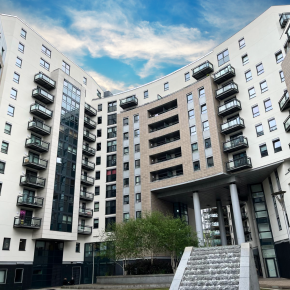
GUEST ARTICLE: How transport hubs help to create a ‘Good City’
It’s never an easy task to persuade humans to change their behaviour; but when it comes to making our cities more sustainable, it’s crucial that we do. We need to incentivise people to use public transport, cycle, walk, use an electric car or scooter by making it easy and attractive to do so. Over the last few years, the emergence of a new kind of transport interchange, or mobility hub, has been seeking to do just that.
 They’re changing the way we travel for the better; but how? Matt Mayes, architect director at multidisciplinary design practice BDP, answers that question…
They’re changing the way we travel for the better; but how? Matt Mayes, architect director at multidisciplinary design practice BDP, answers that question…
Firstly, consider that there are many neglected transport hubs up and down the country ripe for reinvention. They’re usually single-storey bus stations or train stations, spread out across a site inefficiently, with a lack of interconnectivity with wider transport options for inward or onward travel.
They certainly don’t inspire us to jump on a bus or a bike. Bar a coffee stand, they usually don’t have a lot else to offer retail wise and wider uses, like housing, have been overlooked.
Today, we are making our transport hubs work much harder. Much better connectivity to local active travel options, for example cycle or walking routes, reduce congestion, lower CO2 emissions and improve air quality. Improved or expanded bus or train services, which are well connected with one another, make public transport more convenient and appealing.
Infrastructure supports EV charging, scooters and bikes. Amazon lockers offer convenience. Densification of the site to add housing, workspace or other public facilities, helps meet a city’s wider needs and can bring in private sector investment, not to mention instigate further regeneration.

Prime examples
The new Cardiff Transport Interchange and the second phase of Arle Court – both designed by BDP – are prime examples. The former creates a sustainable travel gateway to Cardiff, integrating bus and rail with local walking routes, cycle ways and taxis. With housing above the hub, plus space for retail and food outlets, it makes the best use of a tight city centre site.
Arle Court, meanwhile, is transforming the travel experience for people in the west Cheltenham area, as well as those arriving from the M5 via long-distance coach travel, by providing enhanced park and ride facilities, also combined with better connectivity to local active travel options and significant EV charging.
The mobility hub concept helps to create cities that make people happier and healthier, a subject we explore in our Good City initiative, which aims to address some of the most pressing urban challenges by bringing together experts from across the world.
Efficient mass transit transport systems that support people to make their ‘last mile’ journeys sustainably help to reduce the need for the car, in turn meaning we can reclaim the streets for people.
Think pedestrianised areas, ‘play streets’ for children, or additional green spaces – the opportunities are endless. Too many cities are congested and polluted with inefficient public transport, failing to provide a good quality of life for residents; but they can be good for us, and they should be.
Photo credits: BDP
Latest news

4th February 2025
Delta Membranes: An Education in Waterproofing
As proud members of the RIBA CPD Providers Network, Delta Membranes can offer its CPDs as double point RIBA Accredited.
Posted in Articles, Building Industry Events, Building Industry News, Building Products & Structures, Building Regulations & Accreditations, Building Services, Continuing Professional Development (CPD's), Damp & Waterproofing, Facility Management & Building Services, Information Technology, Restoration & Refurbishment, Retrofit & Renovation, Seminars, Training
4th February 2025
Wetherby Wall Systems: Guiding the Industry Through Gateway 2 Compliance
As the construction sector adapts to the UK’s Building Safety Act 2022, Wetherby Wall Systems, part of the ROCKWOOL Group, is positioned to support industry professionals in navigating the new regulatory landscape.
Posted in Articles, Building Industry News, Building Products & Structures, Building Regulations & Accreditations, Building Services, Building Systems, Cladding, Facades, Facility Management & Building Services, Insulation, Posts, Restoration & Refurbishment, Retrofit & Renovation, Security and Fire Protection, Walls
3rd February 2025
Senior takes the lead on sustainability with new appointment
Senior Architectural Systems, the UK’s largest privately-owned manufacturer of aluminium windows, doors, and curtain walling, has appointed Luke Osborne to the newly created role of UK sustainability lead.
Posted in Aluminium Products, Architectural Ironmongery, Articles, Building Industry News, Building Products & Structures, Building Regulations & Accreditations, Building Systems, Doors, Recruitment, Restoration & Refurbishment, Retrofit & Renovation, Sustainability & Energy Efficiency, Windows
3rd February 2025
Gilberts: The Fine Detail of Special Needs Support
The ‘outstanding’ Highfurlong School is demonstrating its excellence via the attention to detail in its new extension – even the Gilberts ventilation has been chosen to support specific pupil needs.
Posted in Air Conditioning, Articles, Building Industry News, Building Products & Structures, Building Services, Case Studies, Facility Management & Building Services, Heating, Ventilation and Air Conditioning - HVAC, Posts, Restoration & Refurbishment, Retrofit & Renovation
 Sign up:
Sign up: